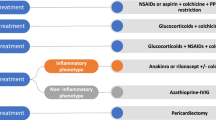Summary
Among the cardiomyopathies, – dilated cardiomyopathy (dcm), hypertrophic cardiomyopathy, restrictive cardiomyopathy, arrhythmogenic right ventricular cardiomyopathy –, dcm is the most frequent entity. Its prevalence in the United States amounts to 36 cases per 100000 inhabitants, men being almost 3-fold more involved than women. The etiology of dcm is very heterogenous; 50% of the cases are due to idiopathic dcm whereas the other half comprises a broad spectrum of various etiologies such as myocarditis, ischemic heart disease, peripartal cardiomyopathy, hypertension, HIV infection, toxic cardiomyopathy and others. In 20 to 30% of the cases of idiopathic dcm a genetic transmission of the disease has been found. Another 20 to 30% of idiopathic dcm are associated with inflammatory and immunological phenomena. Infectious myocarditis with enteroviruses, especially with coxsackie-virus type B has been suggested to be an important trigger for an immune-mediated dcm. In both, familiar dcm and infection with coxsackie-virus B, an impairment of constituents of the myocardial cytoskeleton has been shown. This regarded as a possible pathogenetic mechanism in the development of dcm.
Zusammenfassung
Unter den Kardiomyopathien – dilatative Kardiomyopathie (DCM), hypertrophische Kardiomyopathie, restriktive Kardiomyopathie, arrhythmogene rechtsventrikuläre Kardiomyopathie – stellt die DCM die häufigste Form dar. Ihre Prävalenz wird in den Vereinigten Staaten mit 36 Fällen auf 100.000 Einwohnern angegeben, Männer sind im Verhältnis von fast 3:1 häufiger betroffen als Frauen. Die Ätiologie der DCM ist sehr heterogen, 50% der Fälle gehen auf eine idiopathische DCM zurück, die anderen 50% verteilen sich auf ein breites Spektrum unterschiedlicher Ätiologie wie Myokarditis, ischämische Kardiomyopathie, infiltrative Kardiomyopathie, peripartale Kardiomyopathie, hypertensive Herzerkrankung, HIV-Infektion, toxische Kardiomyopathie u. a. Bei 20–30% der an idiopathischer Kardiomyopathie Erkrankten kann eine familiäre Genese nachgewiesen werden. Weitere 20–30% der idiopathischen DCM werden in Verbindung mit immunologischen Vorgägen gebracht, wobei in den industrialisierten Ländern eine Virusmyokarditis, insbesondere mit Enteroviren der Coxsackie-Virus-B-Gruppe als wesentlicher Auslöser angesehen wird. Sowohl bei der familiären DCM als auch bei einer Infektion mit Coxsackie-Virus B wurden Defekte in Proteinen des Zytoskeletts festgestellt, so dass möglicherweise die Schädigung von Bestandteilen des myokardialen Zytoskeletts ein pathogenetisches Prinzip in der Entstehung der DCM darstellt.
Similar content being viewed by others
Author information
Authors and Affiliations
Rights and permissions
About this article
Cite this article
Olbrich, HG. Epidemiologie –Ätiologie der dilatativen Kardiomyopathie. Z Kardiol 90 (Suppl 1), I2–I9 (2001). https://doi.org/10.1007/s003920170052
Issue Date:
DOI: https://doi.org/10.1007/s003920170052




